From the Backyard to Our Beds: The Spectrum of Care, Attitudes, Relationship Types, and Welfare in Non-Commercial Chicken Care
Abstract
Simple Summary
Abstract
1. Introduction
1.1. Current Knowledge of Non-Commercial Chicken Care
1.2. Attitudes towards Chickens and the Human–Chicken Relationship
1.3. Research Questions
- What chicken care-taking practices and attitudes towards chickens do different kinds of chicken carer have?
- What type of relationship do different kinds of chicken carers have with their chickens?
- Is there a relationship between the care-taking practices, the human–chicken relationship, or attitudes towards chickens?
- What are the biggest challenges owners experience in safeguarding chicken welfare?
2. Materials and Methods
2.1. Research Design
2.2. Analysis
2.3. Research Ethics
2.4. Pilot Study
- The human demographic questions were relocated to the end of the questionnaire.
- Explicit instructions for respondents were added regarding which chicken to consider when answering the OBRS [34]–namely, the chicken the respondent felt closest to.
- All mentions of “bird” in the OBRS [34] were changed to “chicken”.
- Definitions for “coop” and “run” were added.
- More options were added to some questions, and some questions were altered to enable the selection of multiple options.
- Minor typographical and syntactical errors were corrected.
3. Results
3.1. Human Demographics
3.2. Chicken Demographics
3.2.1. Ex-Commercial Chickens
3.2.2. Indoor and Disabled Chickens
3.3. What Chicken Care-Taking Practices Do Chicken Carers Have?
3.3.1. General/Chicken Living Quarters
3.3.2. Health
Minimum Temperatures and Chicken Weights
Treatment and Veterinary Care
Implanting Hens
Chicken Deaths
3.3.3. Other Care-Taking Practices
3.4. What Attitudes towards Chickens Do Chicken Carers Have?
3.5. What Type of Relationship Do Chicken Carers Have with Their Chickens?
3.6. Significant Differences in Care, Relationship, and Attitude between Different Types of Carer
- Where respondents source chickens and country of residence;
- Whether respondents care for hens/cocks/both and country of residence;
- Where respondents sourced most of their chickens and preferred role name;
- Whether respondents regularly use implants and gender;
- Whether respondents regularly use implants and diets;
- Whether respondents had heard of the implants and human age; and
- Whether respondents had heard of the implants and diet.
3.7. Is There a Relationship between the Care-Taking Practices, the Human–Chicken Relationship, or Attitudes towards Chickens?
3.8. What Are the Biggest Challenges Owners Experience in Safeguarding Chicken Welfare?
4. Discussion
4.1. Implants
4.2. Diet/Consumption Habits of Chicken Carers
4.3. Indoor/Disabled Chickens, Hens Eating Eggs, Chicken Sweaters, and Chicken Rescue
4.4. Correlations with Chicken Relational Closeness: Anthropomorphism
4.5. Roosters
4.6. Study Limitations
5. Conclusions
Supplementary Materials
Author Contributions
Funding
Institutional Review Board Statement
Informed Consent Statement
Data Availability Statement
Acknowledgments
Conflicts of Interest
References
- ChickenGuard. How to Keep Chickens—Can You Keep Chickens in the UK? 2020. Available online: https://www.chickenguard.co.uk/how-to-keep-chickens-can-you-keep-chickens-in-the-uk/ (accessed on 31 March 2023).
- Everett, F. Move over Dogs and Cats, Chickens Are Becoming Our New Favourite Pets. The Telegraph 2020. Available online: https://www.telegraph.co.uk/pets/news-features/move-dogs-cats-chickens-becoming-new-favourite-pets/ (accessed on 31 March 2023).
- Spots.com. Pet Ownership Statistics. 2023. Available online: https://spots.com/pet-ownership-statistics/ (accessed on 31 March 2023).
- AVMA U.S. Pet Ownership Statistics. 2023. Available online: https://www.avma.org/resources-tools/reports-statistics/us-pet-ownership-statistics (accessed on 31 March 2023).
- Statista. Number of Households in the U.S. from 1960 to 2022. 2023. Available online: https://www.statista.com/statistics/183635/number-of-households-in-the-us/ (accessed on 31 March 2023).
- APPA [American Pet Product Association]. The 2021–2022 APPA National Pet Owners Survey; APPA: Stamford, CT, USA, 2022; Available online: https://americanpetproducts.org/Uploads/MemServices/INFO_Chickens_10-22_reduce.pdf (accessed on 31 March 2023).
- Megna, M. Pet Ownership Statistics 2023. Forbes Advisor; 2023. Available online: https://www.forbes.com/advisor/pet-insurance/pet-ownership-statistics/ (accessed on 31 March 2023).
- MRCVSonline. Fears over Surge in Abandoned “Lockdown” Chickens. 2020. Available online: https://mrcvs.co.uk/en//news/20011/Fears-over-surge-in-abandoned-%27lockdown%27-chickens (accessed on 31 March 2021).
- Verdolini, G. Meghan Markle and Prince Harry Rescue Chickens and Show Off Their Coop. The Beet; 2021. Available online: https://thebeet.com/meghan-markle-prince-harry-rescue-chickens-and-show-off-their-coop/ (accessed on 31 March 2023).
- BHWT. We’re the British Hen Welfare Trust, a Charity Committed to Changing the Lives of Commercial Laying Hens since 2005. 2023. Available online: https://www.bhwt.org.uk/ (accessed on 31 March 2023).
- Dogs Trust. Our impact. 2023. Available online: https://www.dogstrust.org.uk/about-us/accounts-annual-reviews (accessed on 31 March 2023).
- Champs Libres Aux Poules. Champs Libres Aux Poules. 2021. Available online: https://www.champslibresauxpoules.com/ (accessed on 31 October 2023).
- Ayala, A.J.; Yabsley, M.J.; Hernandez, S.M. A review of pathogen transmission at the backyard chicken–wild bird interface. Front. Vet. Sci. 2020, 7, 539925. [Google Scholar] [CrossRef]
- Correia-Gomes, C.; Sparks, N. Exploring the attitudes of backyard poultry keepers to health and biosecurity. Prev. Vet. Med. 2020, 174, 104812. [Google Scholar] [CrossRef] [PubMed]
- Kyle, C.; Sutherland, L.-A. Understanding Backyard Poultry Keepers and Their Attitudes to Biosecurity: Preliminary Report; Centre of Expertise on Animal Disease Outbreaks: Edinburgh, Scotland, 2018; Available online: https://www.epicscotland.org/media/1560/final-report-smallflocks-and-biosecurity.pdf (accessed on 31 March 2023).
- Lockhart, C.Y.; Stevenson, M.A.; Rawdon, T.G. A cross-sectional study of ownership of backyard poultry in two areas of Palmerston North, New Zealand. N. Z. Vet. J. 2010, 58, 155–159. [Google Scholar] [CrossRef] [PubMed]
- Zoubek, E. From Egg to Dead: Small-Scale Chicken Keeping in Modern Britain. Ph.D. Thesis, University Roehampton, Surrey, UK, 2018. [Google Scholar]
- Souvestre, M.; Delpont, M.; Guinat, C.; Dumat, C.; Guichard, L.; Manis, L.; Duret, H.; Guérin, J.L.; Le Loc’h, G. Backyard poultry flocks in France: A diversity of owners and biosecurity practices. Prev. Vet. Med. 2021, 197, 105511. [Google Scholar] [CrossRef] [PubMed]
- Singleton, D.A.; Ball, C.; Rennie, C.; Coxon, C.; Ganapathy, K.; Jones, P.H.; Welchman, D.; Tulloch, J.S. Backyard poultry cases in UK small animal practices: Demographics, health conditions and pharmaceutical prescriptions. Vet. Rec. 2021, 188, e71. [Google Scholar] [CrossRef]
- Demetriou, S.C. Cultivating Care: Backyard Hens and the Changing Geography of Human-Chicken Relations in Toronto. Master’s Thesis, University Toronto, Toronto, ON, Canada, 2021. [Google Scholar]
- Karabozhilova, I.; Wieland, B.; Alonso, S.; Salonen, L.; Häsler, B. Backyard chicken keeping in the Greater London Urban Area: Welfare status, biosecurity and disease control issues. Br. Poult. Sci. 2012, 53, 421–430. [Google Scholar] [CrossRef]
- Danovich, T. Under the Henfluence; Will. Collins: Glasgow, UK, 2023. [Google Scholar]
- Open Sanctuary. Suprelorin Implants. 2020. Available online: https://opensanctuary.org/article/suprelorin-implants-a-critical-tool-in-chicken-health/ (accessed on 31 March 2021).
- Elkhoraibi, C.; Blatchford, R.A.; Pitesky, M.E.; Mench, J.A. Backyard chickens in the United States: A survey of flock owners. Poult. Sci. 2014, 93, 2920–2931. [Google Scholar] [CrossRef]
- Pohjola, L.; Rossow, L.; Huovilainen, A.; Soveri, T.; Hänninen, M.L.; Fredriksson-Ahomaa, M. Questionnaire study and postmortem findings in backyard chicken flocks in Finland. Acta Vet. Scand. 2015, 57, 3. [Google Scholar] [CrossRef]
- Singleton, D.A.; Sánchez-Vizcaíno, F.; Arsevska, E.; Dawson, S.; Jones, P.H.; Noble, P.J.M.; Pinchbeck, G.L.; Williams, N.J.; Radford, A.D. New approaches to pharmacosurveillance for monitoring prescription frequency, diversity, and co-prescription in a large sentinel network of companion animal veterinary practices in the United Kingdom, 2014–2016. Prev. Vet. Med. 2018, 159, 153–161. [Google Scholar] [CrossRef]
- Taggers, A.; Baron, H. A retrospective study of 333 emergency presentations and survival to discharge of backyard chickens in Australia from 2019 to 2022. Aust. Vet. J. 2023, 101, 212–217. [Google Scholar] [CrossRef]
- Vaught, M.E.; Gladden, J.N.; Rozanski, A.N. Reasons for evaluation on an emergency basis of and short-term outcomes for chickens from backyard flocks: 78 cases (2014–2017). J. Am. Vet. Med. Assoc. 2019, 254, 1196–1203. [Google Scholar] [CrossRef] [PubMed]
- Arluke, A.; Sanders, S. Regarding Animals; Temple University Press: Philadelphia, PA, USA, 1996. [Google Scholar]
- Macauley, L. Friends, Food, or “Free Egg Machines”? A Qualitative Study of Chicken Owners’ Perceptions of Chickens and Chicken Meat. BSc Thesis, University Adelaide, Adelaide, Australia, 2018. Available online: https://hekyll.services.adelaide.edu.au/dspace/handle/2440/14759/browse?type=author&order=ASC&rpp=95&value=Macauley%2C+Luke+Peter+James (accessed on 31 March 2023).
- Oliver, C. Returning to “The Good Life”? Chickens and chicken-keeping during COVID-19 in Britain. Anim. Stud. J. 2021, 10, 114–139. [Google Scholar] [CrossRef]
- Herzog, H.; Grayson, S.; McCord, D. Brief measures of the animal attitude scale. Anthrozoos 2015, 28, 145–152. [Google Scholar] [CrossRef]
- Robertson, J.C.; Gallivan, J.; Maclntyre, P.D. Sex differences in the antecedents of animal use attitudes. Anthrozoos 2004, 17, 306–319. [Google Scholar] [CrossRef]
- Burmeister, A.K.; Drasch, K.; Rinder, M.; Prechsl, S.; Peschel, A.; Korbel, R.; Saam, N.J. Development and application of the Owner-Bird Relationship Scale (OBRS) to assess the relation of humans to their pet birds. Front. Vet. Sci. 2020, 7, 1055. [Google Scholar] [CrossRef] [PubMed]
- Macauley, L.; Chur-Hansen, A. Human health benefits of non-conventional companion animals: A narrative review. Animals 2023, 13, 28. [Google Scholar] [CrossRef]
- Blatchford, R.A. Backyard flock production. In Advances in Poultry Welfare; Mench, J.A., Ed.; Elsevier Ltd.: Duxford, UK, 2017; pp. 339–350. [Google Scholar]
- Lister, S.A. Opportunities and challenges in backyard poultry health and management. Vet. Rec. 2021, 188, 262–264. [Google Scholar] [CrossRef]
- Eusemann, B.K.; Sharifi, A.R.; Patt, A.; Reinhard, A.K.; Schrader, L.; Thöne-Reineke, C.; Petow, S. Influence of a sustained release deslorelin acetate implant on reproductive physiology and associated traits in laying hens. Front. Physiol. 2018, 9, 1846. [Google Scholar] [CrossRef]
- Abou-Zahr, T. Avian reproductive disorders. Companion Anim. 2022, 27, 1–8. [Google Scholar] [CrossRef]
- Davies, G. Common ailments of pet hens. Vet. Nurs. J. 2016, 31, 186–189. [Google Scholar] [CrossRef]
- Greenacre, C.B. Reproductive diseases of the backyard hen. J. Exot. Pet Med. 2015, 24, 164–171. [Google Scholar] [CrossRef] [PubMed]
- BHWT. What Is Egg Yolk Peritonitis? 2023. Available online: https://www.bhwt.org.uk/blog/health-welfare/egg-yolk-peritonitis/ (accessed on 31 March 2023).
- Online Surveys. About Online Surveys. 2019. Available online: https://www.onlinesurveys.ac.uk/about/ (accessed on 31 October 2023).
- Saam, N.; Rinder, M.; Drasch, K. Personal communication, 2022.
- SurveyMonkey Sample Size Calculator. n.d. Available online: https://www.surveymonkey.co.uk/mp/sample-size-calculator/ (accessed on 31 October 2023).
- Architecture & Design. How Many Houses Are in the World? 2021. Available online: https://www.architectureanddesign.com.au/features/list/how-many-houses-are-in-the-world (accessed on 31 March 2023).
- Bryman, A. Quantitative data analysis. In Social Research Methods, 5th ed.; Oxford University Press: Oxford, UK, 2016; pp. 329–352. [Google Scholar]
- Field, A. Discovering Statistics Using IBM SPSS Statistics, 4th ed.; Sage Public: Thousand Oaks, CA, USA, 2013. [Google Scholar]
- Marchant-Shapiro, T. Chi-square and Cramer’s V: What do you expect? In Statistics for Political Analysis: Understanding the Numbers; Sage Public: Thousand Oaks, CA, USA, 2015; pp. 245–272. [Google Scholar]
- McHugh, M.L. The chi-square test of independence. Biochem. Med. 2013, 23, 143–149. [Google Scholar] [CrossRef] [PubMed]
- Jayaratne, S.; Tripodi, T.; Talsma, E. The comparative analysis and aggregation of single-case data. J. Appl. Behav. Sci. 1988, 24, 119–128. [Google Scholar] [CrossRef]
- Weymouth, A. Using hardwood woodchip for your chicken run. Flyte So Fancy 2022. Available online: https://www.flytesofancy.co.uk/blogs/information-centre/using-hardwood-woodchip-for-your-chicken-run (accessed on 31 March 2023).
- Roberts, V. How to navigate through the regulations and medications for backyard and pet poultry. Livestock 2020, 25, 45–50. [Google Scholar] [CrossRef]
- Joy, M. Why We Love Dogs, Eat Pigs, and Wear Cows: An Introduction to Carnism; Conari Press: San Francisco, CA, USA, 2010. [Google Scholar]
- Mace, J.L.; McCulloch, S.P. Yoga, ahimsa and consuming animals: UK yoga teachers’ beliefs about farmed animals and attitudes to plant-based diets. Animals 2020, 10, 480. [Google Scholar] [CrossRef] [PubMed]
- Gopnik, A.; Griffiths, T.L.; Lucas, C.G. When younger learners can be better (or at least more open-minded) than older ones. Curr. Dir. Psychol. Sci. 2015, 24, 87–92. [Google Scholar] [CrossRef]
- FDA. Suprelorin® F (Deslorelin Acetate). 2023. Available online: https://www.fda.gov/media/83933/download (accessed on 31 March 2023).
- Rosenzweig, A. Ask FDA to Approve Chicken Implants to Prevent Egg Laying (Deslorelin). 2022. Available online: https://www.change.org/p/ask-fda-to-approve-chicken-implants-to-prevent-egg-laying-deslorelin?utm_content=cl_sharecopy_34293796_en-US%3A9&recruited_by_id=163bf820-2495-11ee-b860-5dd9390be998&utm_source=share_petition&utm_medium=copylink&utm_campaign=psf_combo_share_initial&share_bandit_exp=skip-34293796-en-GB (accessed on 31 March 2023).
- YouGov. Dietary Choices of Brits. 2023. Available online: https://yougov.co.uk/topics/society/trackers/dietery-choices-of-brits-eg-vegeterian-flexitarian-meat-eater-etc (accessed on 31 March 2023).
- Statista Research Department. Veganism and Vegetarianism in the United States—Statistics & Facts. 2023. Available online: https://www.statista.com/topics/3377/vegan-market/#topicOverview (accessed on 31 March 2023).
- Dodd, S.A.; Cave, N.J.; Adolphe, J.L.; Shoveller, A.K.; Verbrugghe, A. Plant-based (vegan) diets for pets: A survey of pet owner attitudes and feeding practices. PLoS ONE 2019, 14, e0210806. [Google Scholar] [CrossRef]
- Donaldson, S.; Kymlicka, W. Zoopolis: A Political Theory of Animal Rights; Oxford University Press: Oxford, UK, 2011. [Google Scholar]
- Wolf, A. The Ethics of Proximity: A Defense of Different Ethical Duties to Friends and Family. Epoché 2021, 47. Available online: https://epochemagazine.org/47/the-ethics-of-proximity-a-defense-of-different-ethical-duties-to-friends-and-family/ (accessed on 31 March 2023).
- Pollock, C. Backyard poultry in clinical avian practice. J. Avian Med. Surg. 2016, 30, 392–404. [Google Scholar] [CrossRef]
- Hess, T.; Magnus, J. Sharing Your Home with Chickens. The Open Sanctuary Project. 2021. Available online: https://opensanctuary.org/indoorchickens/ (accessed on 31 March 2023).
- Mellor, D.J. Updating animal welfare thinking: Moving beyond the “five freedoms” towards “A life worth living”. Animals 2016, 6, 21. [Google Scholar] [CrossRef]
- Yilmaz Dikmen, B. Laying hen behaviour and welfare in housing systems. In Proceedings of the 25th International Scientific Experts Congress on Agriculture and Food Industry, Izmir, Turkey, 25–27 September 2014; pp. 45–48. Available online: https://xdocs.pub/doc/voarska-rejonizacija-u-federaciji-bosne-i-hercegovine-2856md93jmnx#page=58 (accessed on 31 March 2023).
- Henke, J. Stop Chickens from Eating Eggs. 2021. Available online: https://www.agriculture.com/podcast/living-the-country-life-radio/stop-chickens-from-eating-eggs (accessed on 31 October 2023).
- Calder, C.; Albright, J. Chicken behaviour. In Backyard Poultry Medicine and Surgery; Morishita, T.Y., Greenacre, C.B., Eds.; Wiley: Hoboken, NJ, USA, 2021; pp. 434–454. [Google Scholar]
- Open Sanctuary. What Should a Sanctuary do with Residents’ Eggs? 2018. Available online: https://opensanctuary.org/what-to-do-about-egg-laying/ (accessed on 31 March 2023).
- Steele, L. Myths about feeding your chickens eggshells. Fresh Eggs Daily 2023. Available online: https://www.fresheggsdaily.blog/2017/05/5-easy-steps-to-feeding-your-chickens.html (accessed on 31 October 2023).
- The Chicken Chick®. Chicken Sweaters: Just Say No. 2023. Available online: https://the-chicken-chick.com/chicken-sweaters-just-say-no/ (accessed on 31 July 2023).
- Burmeister, A.K.; Drasch, K.; Rinder, M.; Prechsl, S.; Peschel, A.; Korbel, R.; Saam, N.J. The owner-bird relationship: Relevance for pet bird welfare. Anim. Welf. 2022, 31, 137–154. [Google Scholar] [CrossRef]
- Magnus, J.; Griffler, M. So You Want to Rescue a Rooster (Brochure). The Open Sanctuary Project. 2023. Available online: https://opensanctuary.org/the-open-sanctuary-projects-so-you-want-to-rescue-a-rooster-brochure/ (accessed on 31 March 2023).
- BHWT. Cockerel Adoption. 2023. Available online: https://www.bhwt.org.uk/cockerel-adoption/ (accessed on 31 March 2023).
- UK Government. The Mutilations (Permitted Procedures) (England) Regulations 2007. 2007. Available online: https://www.legislation.gov.uk/uksi/2007/1100/schedule/4/made (accessed on 31 March 2023).
- Kirk, I. Should Selective Breeding of Dogs with Health Issues Be Banned? YouGov. 2022. Available online: https://yougov.co.uk/topics/society/articles-reports/2022/04/13/should-selective-breeding-dogs-health-issues-be-ba (accessed on 31 March 2023).
- Kodilinye-Sims, H.; Royden, A. We must improve our pet poultry services. Vet. Rec. 2022, 190, 248–249. [Google Scholar] [CrossRef] [PubMed]
- ECDC [European Centre for Disease Prevention and Control]. 2021–2022 Data Show Largest Avian Flu Epidemic in Europe Ever. 2022. Available online: https://www.ecdc.europa.eu/en/news-events/2021-2022-data-show-largest-avian-flu-epidemic-europe-ever (accessed on 31 March 2023).
- Nicol, C.J. The Behavioural Biology of Chickens; CABI: Wallingford, UK, 2015. [Google Scholar]
- BHWT. Merging Your Flocks. 2023. Available online: https://www.bhwt.org.uk/merging-your-flocks/ (accessed on 31 March 2023).
- HSA. Electrical Stunning Equipment. 2023. Available online: https://www.hsa.org.uk/stunning-and-slaughter-electrical-stunning/equipment-3 (accessed on 31 March 2023).
- HSA. Neck Dislocation. 2023. Available online: https://www.hsa.org.uk/neck-dislocation/neck-dislocation (accessed on 31 March 2023).
- HSA. Other Methods. 2023. Available online: https://www.hsa.org.uk/other-methods/other-methods (accessed on 31 March 2023).

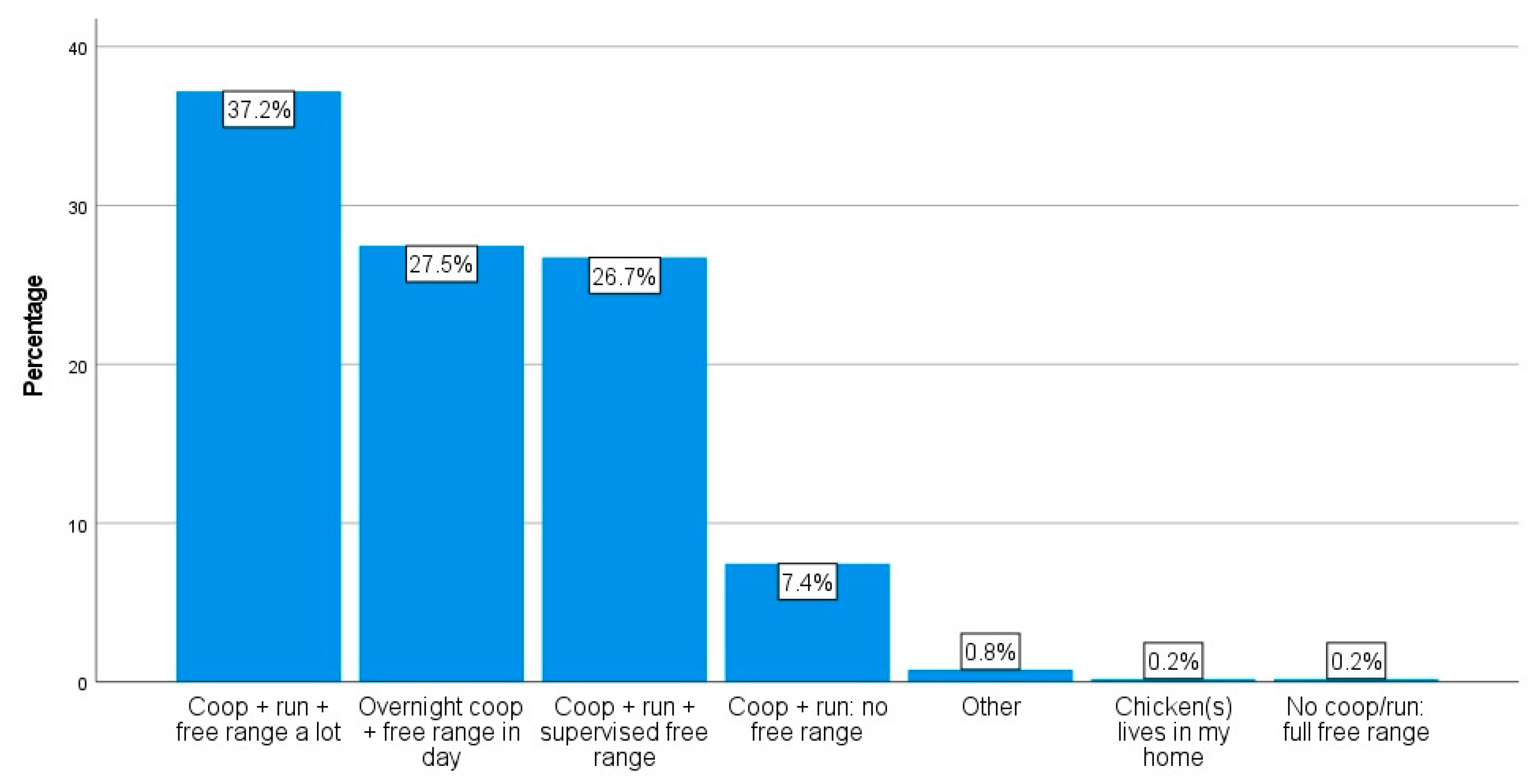


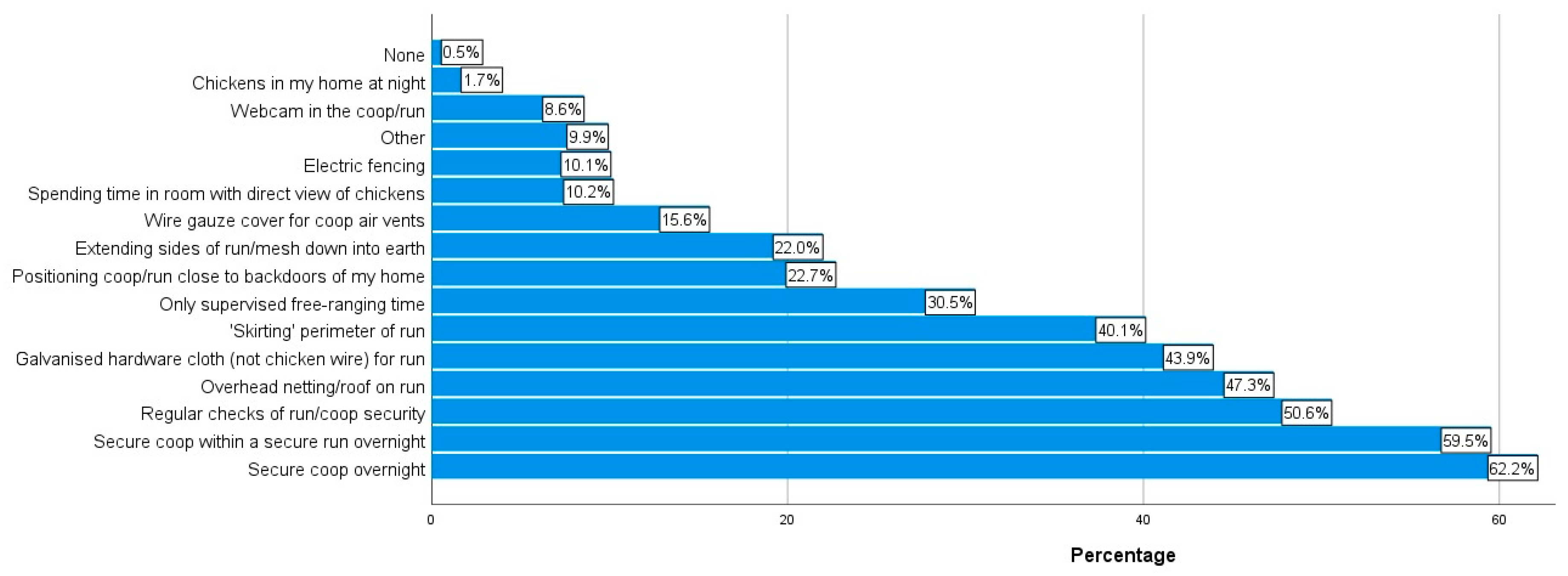
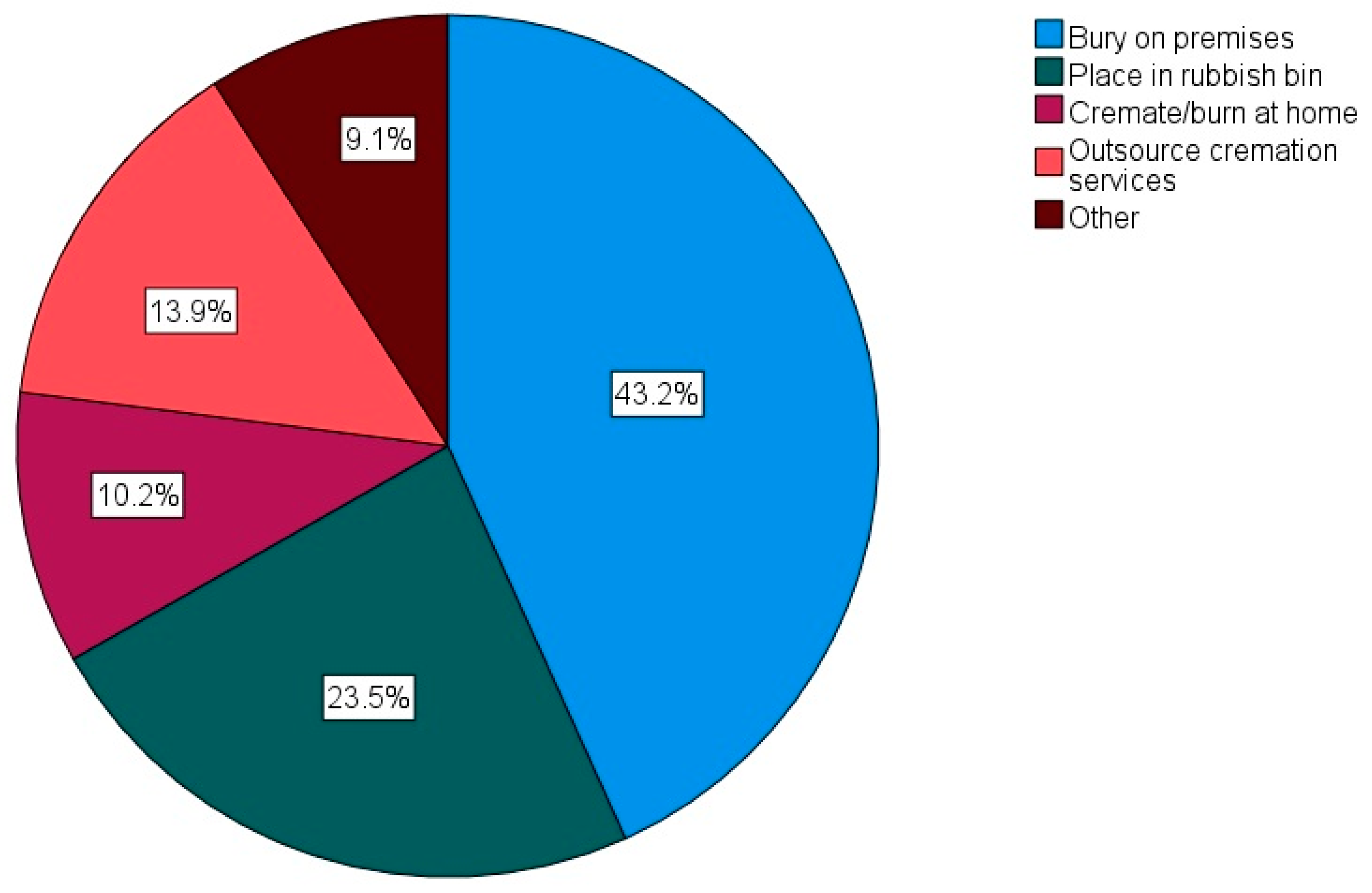
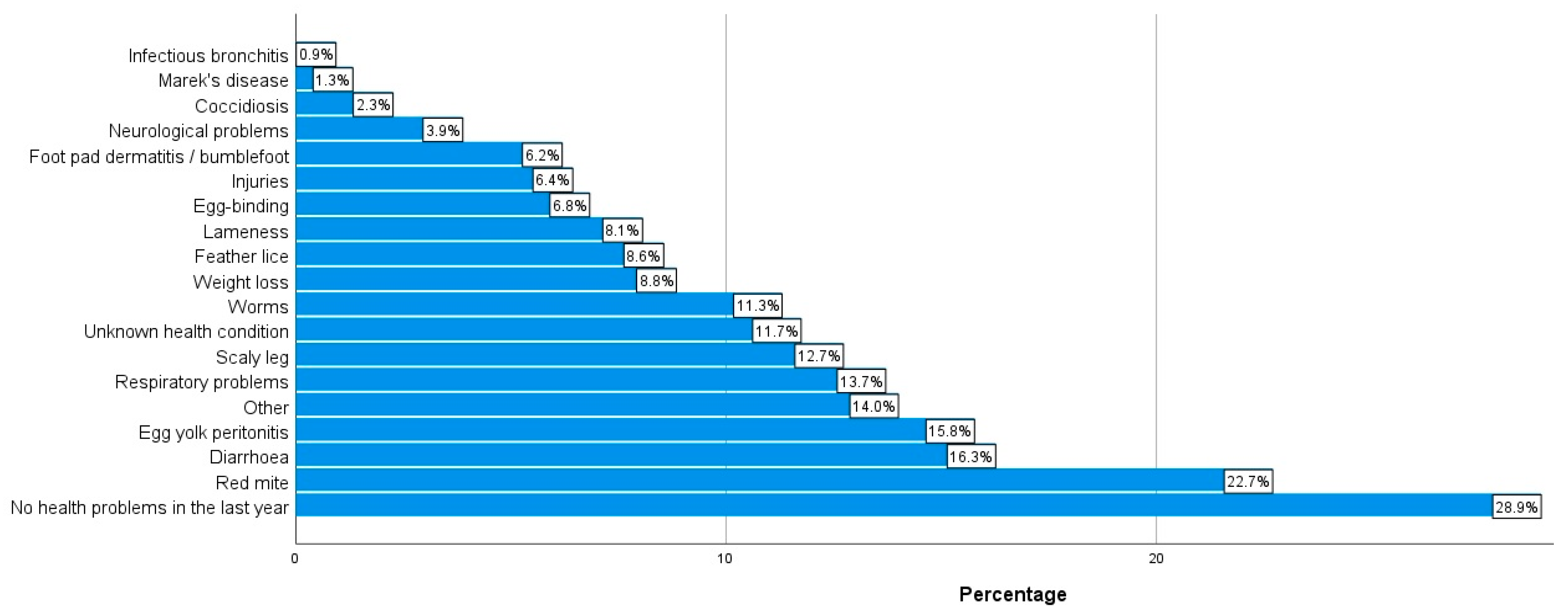

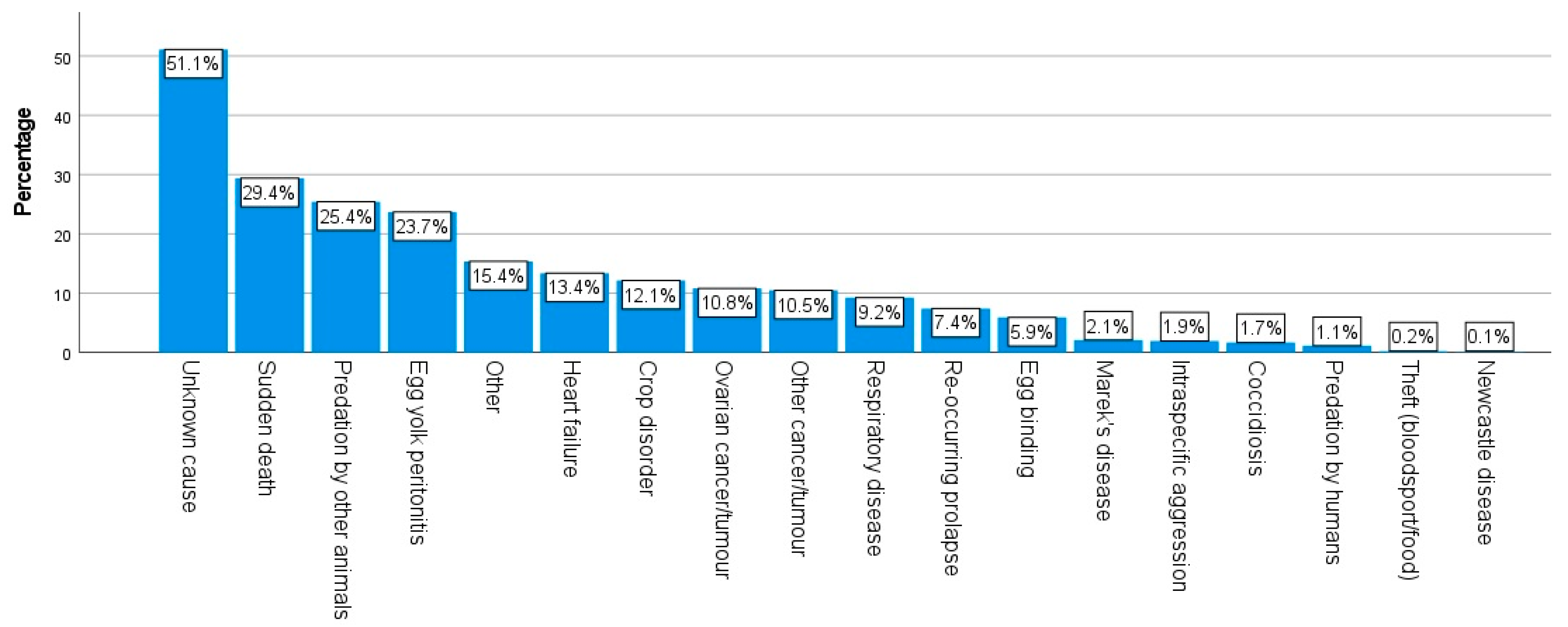
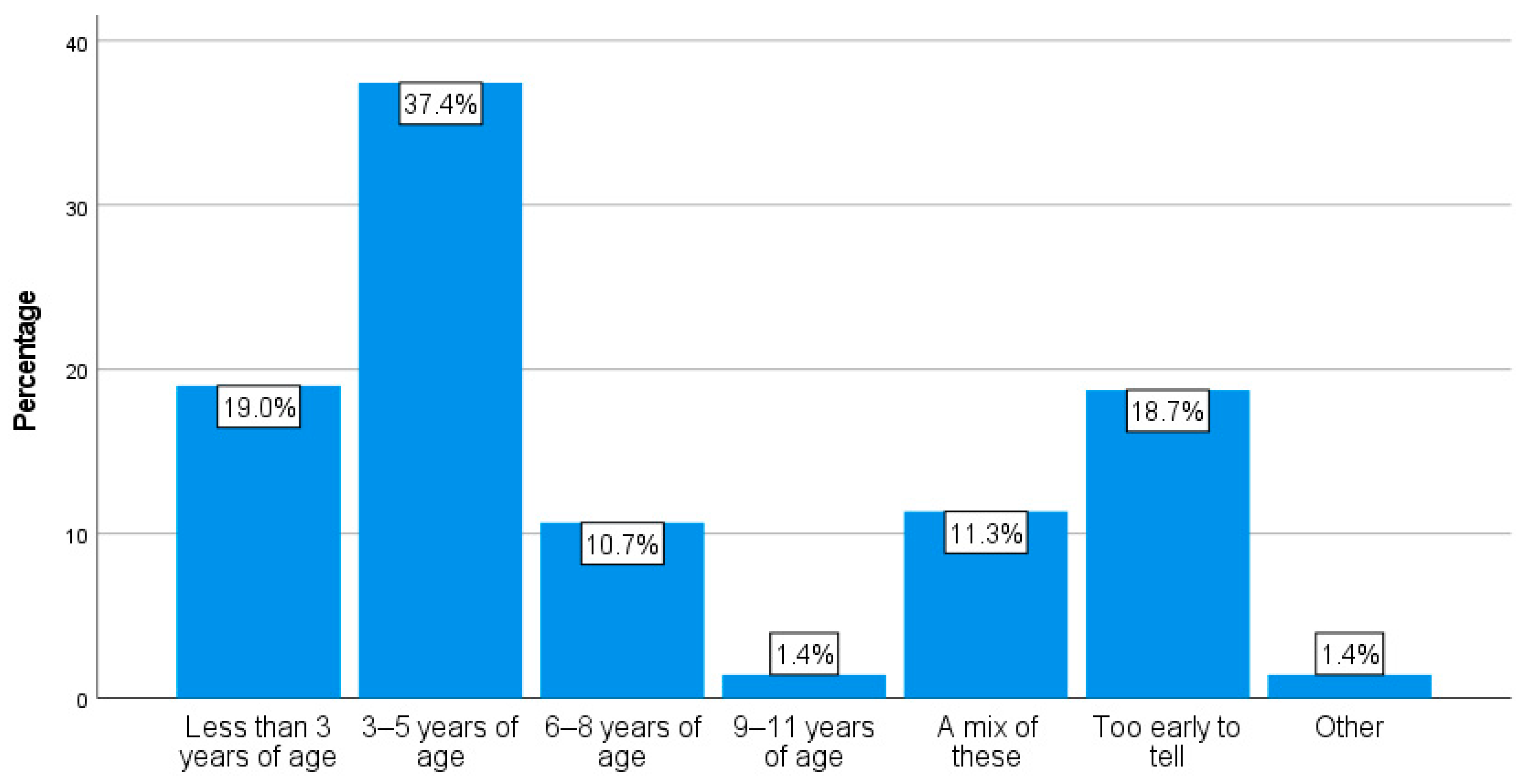
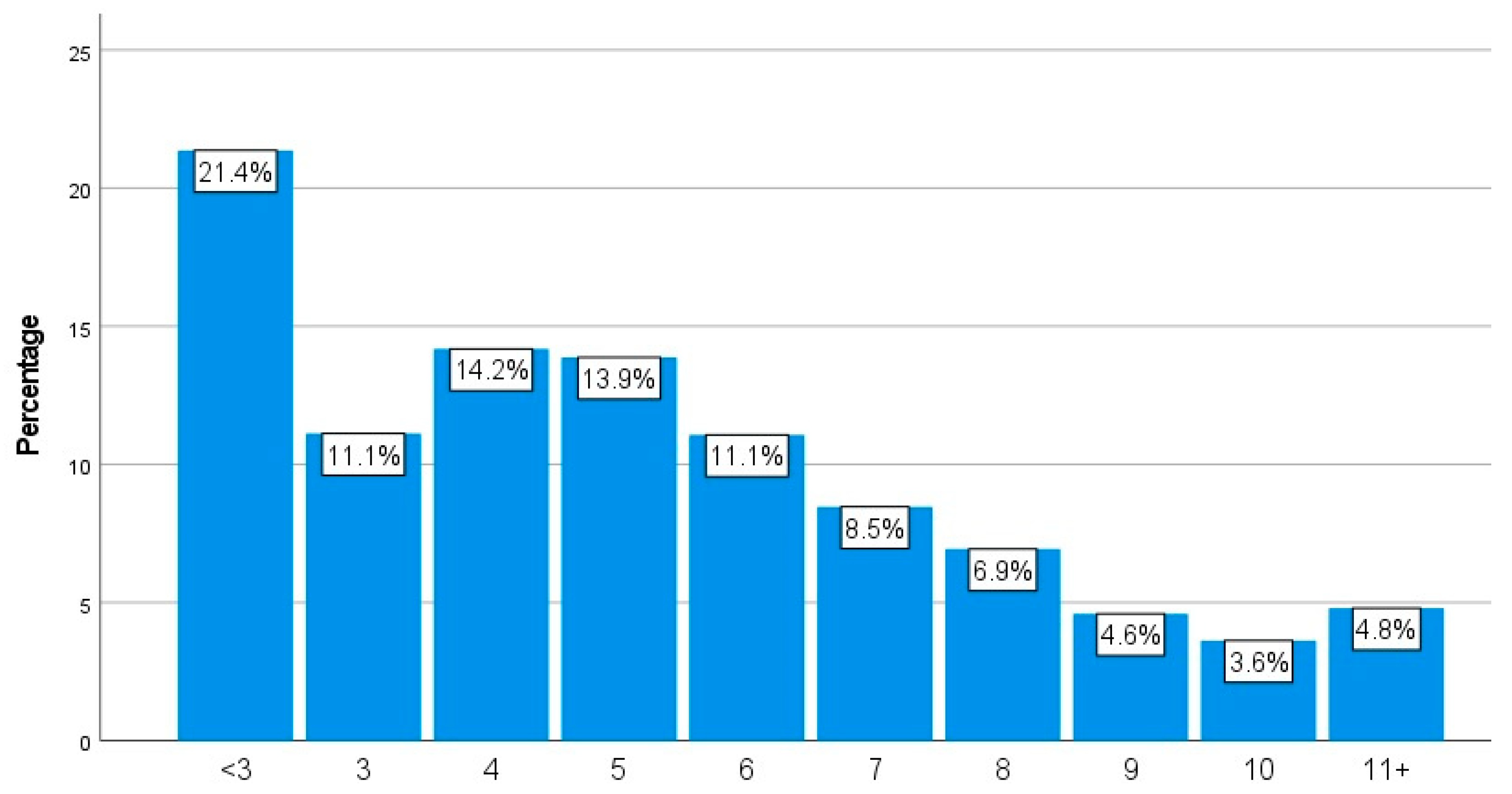
| Never | Rarely | Some-Times | Often | Always | Mean | Std. Deviation | |
|---|---|---|---|---|---|---|---|
| I arrange for someone to care for my chickens when I am away for a weekend | 3.9% | 1.9% | 5.0% | 6.9% | 82.3% | 4.6144 | 0.95841 |
| I ensure my chickens have fresh material for dustbathing in | 1.2% | 1.9% | 8.2% | 24.7% | 64.0% | 4.4799 | 0.81690 |
| I try to improve my knowledge of optimal care-taking practices for chickens | 0.9% | 2.2% | 13.0% | 33.0% | 50.9% | 4.3088 | 0.83605 |
| I spend time observing my chickens’ behavior | 0.3% | 1.3% | 14.1% | 45.5% | 38.8% | 4.2087 | 0.74941 |
| I conduct periodical health checks of my chickens | 1.1% | 3.8% | 19.8% | 42.0% | 33.4% | 4.0238 | 0.88739 |
| I introduce new chickens to a flock gradually over a period of a few weeks | 12.2% | 5.8% | 13.5% | 13.1% | 55.4% | 3.9507 | 1.40565 |
| I clean my chickens’ hind feathers if they become very soiled | 7.8% | 8.4% | 20.9% | 19.7% | 43.1% | 3.8199 | 1.28807 |
| I deworm the chickens or send off fecal samples for testing at the corresponding recommended time intervals | 24.4% | 7.8% | 15.0% | 21.6% | 31.2% | 3.2924 | 1.55905 |
| Regardless of the cost, if there is a treatment that could help my chicken, then I pay for it or fundraise for it if I can’t afford it | 20.1% | 14.4% | 18.5% | 17.0% | 30.1% | 3.2145 | 1.50641 |
| I include a probiotic supplement in my chickens water/feed | 22.1% | 9.1% | 31.6% | 22.0% | 15.2% | 2.9852 | 1.33748 |
| ** I prefer natural deaths at home for chickens over euthanasia | 5.1% | 7.7% | 36.3% | 23.2% | 27.7% | 2.3972 | 1.11645 |
| I let my chickens inside my house if they wish to come in | 42.9% | 16.3% | 19.3% | 10.0% | 11.6% | 2.3162 | 1.39729 |
| I let my chickens rest for long periods inside the house if they wish to | 53.2% | 15.6% | 13.1% | 7.5% | 10.6% | 2.0641 | 1.37609 |
| I feed any eggs my chickens lay back to them | 50.2% | 17.3% | 23.5% | 6.2% | 2.7% | 1.9597 | 1.11095 |
| I have a post-mortem carried out to determine the cause of death if the cause of death of one of my chickens is unknown | 80.3% | 9.5% | 6.6% | 1.6% | 2.0% | 1.3517 | 0.82761 |
| Strongly Disagree | Disagree | Undecided | Agree | Strongly Agree | Mean | Std. Deviation | |
|---|---|---|---|---|---|---|---|
| It is morally wrong to participate in cockfighting in any way | 2.3% | 0.1% | 0.3% | 2.1% | 95.1% | 4.8749 | 0.63658 |
| I sometimes get upset when I see chickens in cages | 2.8% | 2.0% | 2.9% | 22.2% | 70.0% | 4.5483 | 0.87142 |
| ** Basically, humans have the right to use chickens as we see fit | 58.5% | 24.8% | 10.1% | 4.4% | 2.2% | 4.3320 | 0.97434 |
| ** Chickens are morally less important than dogs | 50.1% | 26.2% | 14.5% | 6.1% | 3.0% | 4.1438 | 1.06792 |
| ** Breeding chickens for maximum egg production is morally acceptable | 45.1% | 23.7% | 14.0% | 7.5% | 9.7% | 3.8675 | 1.32224 |
| It is morally wrong to breed chickens when millions of male chickens are unwanted and killed | 6.7% | 12.9% | 29.6% | 21.2% | 29.6% | 3.5493 | 1.22174 |
| ** I think it is perfectly acceptable for chickens to be raised for human consumption | 18.2% | 9.7% | 22.1% | 33.3% | 16.7% | 2.7990 | 1.33571 |
| The slaughter of chickens should be immediately stopped even if it means some people will be put out of work | 19.7% | 32.2% | 22.8% | 8.3% | 17.1% | 2.7192 | 1.33828 |
| ** Sometimes it is necessary to clip chickens’ wings to prevent them jumping/flying too high | 13.2% | 11.7% | 19.7% | 37.4% | 18.0% | 2.6443 | 1.26818 |
| ** I t is morally acceptable to keep chickens for their eggs | 3.8% | 3.9% | 10.9% | 41.9% | 39.5% | 1.9059 | 0.99308 |
| Strongly Disagree | Disagree | Undecided | Agree | Strongly Agree | ||
|---|---|---|---|---|---|---|
| 1 | I enjoy playing with my chicken | 2.9% | 8.9% | 13.8% | 41.9% | 32.4% |
| 2 | I think my chicken understands me | 7.3% | 19.8% | 31.0% | 30.9% | 11.0% |
| 3 | My chicken knows when I am feeling bad | 18.8% | 32.1% | 36.9% | 8.1% | 4.0% |
| 4 | I consider my chicken to be a friend | 10.8% | 21.1% | 17.6% | 33.4% | 17.1% |
| 5 | My chicken is an equal member of my family | 12.4% | 25.7% | 15.1% | 29.4% | 17.4% |
| 6 | Sometimes I wonder what my chicken is thinking | 4.5% | 8.3% | 9.5% | 48.0% | 29.6% |
| 7 | I can talk to my chicken about anything | 14.7% | 17.2% | 16.5% | 28.4% | 23.3% |
| 8 | My chicken is like a child to me | 31.4% | 29.3% | 14.6% | 15.2% | 9.5% |
| 9 | My chicken provides structure for my life | 13.8% | 16.3% | 17.0% | 36.7% | 16.2% |
| 10 | Having a chicken gives me someone to care for | 10.2% | 13.8% | 18.1% | 40.8% | 17.2% |
| 11 | My chicken makes me feel needed | 15.4% | 21.7% | 22.1% | 28.4% | 12.4% |
| 12 | Spending time with my chicken makes me forget my problems for a while | 5.8% | 7.1% | 13.6% | 44.2% | 29.3% |
| 13 | I feel relaxed/more content because of my chicken | 4.1% | 5.9% | 14.6% | 44.7% | 30.7% |
| 14 | I feel distressed when my chicken is ill and I see him/her suffering | 1.5% | 2.1% | 4.0% | 30.9% | 61.6% |
| 15 | When my chicken is ill, it is my duty to care for him/her | 0.3% | 0.2% | 0.7% | 17.3% | 81.5% |
| 16 | I pay attention to my chicken’s body language | 0.5% | 0.8% | 5.8% | 36.3% | 56.6% |
| 17 | My chicken has his/her own unique personality | 0.4% | 0.7% | 3.8% | 25.1% | 70.0% |
| 18 | My chicken is a sensitive being with his/her own needs | 1.1% | 2.0% | 9.5% | 30.4% | 57.1% |
| 19 | My chicken actively tries to be close to me | 4.8% | 11.7% | 23.4% | 36.7% | 23.5% |
| 20 | ** My chicken always tries to keep a little distance from me | 23.4% | 33.3% | 22.9% | 18.5% | 2.1% |
| 21 | ** My chicken ignores me | 50.0% | 29.6% | 14.2% | 4.6% | 1.6% |
| Dimension | ||||||
|---|---|---|---|---|---|---|
| Bird as Human | Social Support | Empathy | Bird Reciprocity | Mean Level of Agreement | Std. Dev. | |
| My chicken knows when I am feeling bad | 0.784 | 0.156 | 0.053 | 0.107 | 2.47 | 1.016 |
| I think my chicken understands me | 0.751 | 0.115 | 0.126 | 0.128 | 3.19 | 1.094 |
| I consider my chicken to be a friend | 0.738 | 0.287 | 0.205 | 0.142 | 3.27 | 1.259 |
| My chicken is an equal member of my family | 0.705 | 0.273 | 0.257 | 0.082 | 3.15 | 1.312 |
| My chicken is like a child to me | 0.624 | 0.433 | 0.136 | 0.080 | 2.44 | 1.323 |
| I can talk to my chicken about anything | 0.619 | 0.373 | 0.221 | 0.044 | 3.29 | 1.372 |
| I enjoy playing with my chicken | 0.538 | 0.179 | 0.254 | 0.178 | 3.93 | 1.025 |
| Having a chicken gives me someone to care for | 0.244 | 0.811 | 0.132 | 0.007 | 3.42 | 1.211 |
| My chicken provides structure for my life | 0.299 | 0.771 | 0.122 | 0.043 | 3.26 | 1.286 |
| My chicken makes me feel needed | 0.339 | 0.765 | 0.110 | 0.032 | 3.02 | 1.267 |
| Spending time with my chicken makes me forget my problems for a while | 0.166 | 0.720 | 0.257 | 0.095 | 3.85 | 1.092 |
| I feel relaxed/more content because of my chicken | 0.186 | 0.679 | 0.303 | 0.122 | 3.93 | 1.013 |
| When my chicken is ill, it is my duty to care for him/her | 0.032 | 0.064 | 0.778 | 0.069 | 4.80 | 0.466 |
| My chicken has his/her own unique personality | 0.297 | 0.100 | 0.711 | 0.080 | 4.64 | 0.626 |
| I pay attention to my chicken’s body language | 0.184 | 0.175 | 0.690 | 0.137 | 4.48 | 0.680 |
| I feel distressed when my chicken is ill and I see him/her suffering | 0.056 | 0.218 | 0.677 | 0.051 | 4.49 | 0.788 |
| My chicken is a sensitive being with his/her own needs | 0.300 | 0.197 | 0.661 | 0.038 | 4.41 | 0.816 |
| Sometimes I wonder what my chicken is thinking | 0.415 | 0.259 | 0.470 | 0.002 | 3.92 | 1.047 |
| ** My chicken always tries to keep a little distance from me | 0.128 | −0.002 | −0.022 | 0.845 | 3.57 | 1.090 |
| ** My chicken ignores me | 0.054 | 0.028 | 0.127 | 0.726 | 4.22 | 0.950 |
| My chicken actively tries to be close to me | 0.328 | 0.241 | 0.213 | 0.638 | 3.63 | 1.102 |
| Rotation Method: Varimax with Kaiser Normalization. Rotation converged in 6 iterations. | ||||||
| Scale | Care Series | CAS | OBRS | ||||
|---|---|---|---|---|---|---|---|
| Carer Type/Style | D1 (Bird as Human) | D2 (Social Support) | D3 (Empathy) | D4 (Bird Reciprocity) | Overall OBRS | ||
| Kruskal–Wallis Test | |||||||
| Source most | 0.333 | 0.000 | 0.143 | 0.655 | 0.041 | <0.001 | 0.139 |
| Hens, cocks, both | <0.001 | 0.765 | 0.504 | 0.579 | 0.362 | 0.007 | 0.794 |
| Hens and cocks separate? | 0.024 | 0.903 | 0.574 | 0.195 | 0.210 | 0.030 | 0.299 |
| Primary caregiver? | 0.197 | 0.189 | 0.592 | 0.490 | 0.592 | 0.636 | 0.775 |
| Vaccinate? | <0.001 | 0.021 | <0.001 | 0.004 | <0.001 | <0.001 | <0.001 |
| Name chickens? | 0.000 | <0.001 | 0.000 | 0.000 | 0.000 | <0.001 | 0.000 |
| Setup | <0.001 | 0.004 | <0.001 | 0.110 | <0.001 | 0.005 | <0.001 |
| Coop material | 0.594 | 0.609 | 0.689 | 0.117 | 0.172 | 0.544 | 0.405 |
| Follow lockdown? | <0.001 | 0.083 | 0.051 | 0.413 | 0.230 | 0.601 | 0.128 |
| Kill to eat? | <0.001 | 0.000 | 0.000 | <0.001 | <0.001 | <0.001 | 0.000 |
| How tend to corpse? | 0.000 | 0.000 | 0.000 | <0.001 | 0.000 | 0.001 | 0.000 |
| Killing method | 0.698 | 0.869 | 0.209 | 0.324 | 0.174 | 0.543 | 0.417 |
| Human diet | 0.000 | 0.000 | 0.000 | <0.001 | 0.000 | <0.001 | 0.000 |
| Human diet group | 0.000 | 0.000 | 0.000 | <0.001 | 0.000 | <0.001 | 0.000 |
| Memorialize? | 0.000 | 0.000 | 0.000 | 0.000 | 0.000 | <0.001 | 0.000 |
| Take to vets? | 0.000 | 0.000 | 0.000 | 0.000 | 0.000 | <0.001 | 0.000 |
| Home treatment success? | <0.001 | 0.211 | 0.108 | 0.121 | 0.201 | 0.037 | 0.025 |
| Happy with vets? | <0.001 | 0.002 | 0.297 | 0.348 | 0.048 | 0.360 | 0.148 |
| Role name | 0.000 | 0.000 | 0.000 | <0.001 | 0.000 | <0.001 | 0.000 |
| Consider implant? | 0.000 | 0.000 | 0.000 | <0.001 | <0.001 | <0.001 | 0.000 |
| Implants improve lifespan | <0.001 | <0.001 | <0.001 | <0.001 | <0.001 | 0.065 | <0.001 |
| Implants improve life quality | <0.001 | <0.001 | <0.001 | 0.006 | <0.001 | 0.630 | <0.001 |
| Regularly use implants | <0.001 | <0.001 | <0.001 | <0.001 | <0.001 | 0.029 | <0.001 |
| Approach if stop laying | <0.001 | <0.001 | <0.001 | 0.006 | <0.001 | 0.003 | <0.001 |
| In will? | 0.000 | <0.001 | <0.001 | <0.001 | <0.001 | <0.001 | <0.001 |
| 10 years’ time | <0.001 | <0.001 | <0.001 | <0.001 | <0.001 | <0.001 | 0.000 |
| Gender | <0.001 | <0.001 | <0.001 | <0.001 | <0.001 | 0.033 | <0.001 |
| Country | 0.001 | 0.227 | <0.001 | <0.001 | <0.001 | 0.030 | <0.001 |
| Home type | 0.009 | 0.013 | <0.001 | <0.001 | 0.016 | 0.169 | <0.001 |
| Occupation | <0.001 | <0.001 | <0.001 | 0.002 | <0.001 | 0.210 | <0.001 |
| Household profile | <0.001 | <0.001 | <0.001 | <0.001 | <0.001 | 0.010 | <0.001 |
| Mann–Whitney U Test | |||||||
| Daily feces removal from run? | 0.000 | <0.001 | 0.000 | <0.001 | <0.001 | <0.001 | 0.000 |
| Heard of implant? | 0.000 | 0.000 | 0.000 | <0.001 | 0.000 | <0.001 | 0.000 |
| Cared for special needs? | <0.001 | <0.001 | <0.001 | <0.001 | <0.001 | 0.078 | <0.001 |
| Able to select closest chicken? | 0.000 | <0.001 | 0.000 | 0.000 | 0.000 | 0.000 | 0.000 |
| Rent? | <0.001 | 0.440 | <0.001 | <0.001 | 0.076 | 0.004 | <0.001 |
| Kruskal–Wallis Test | |||||||
| No. of chickens | <0.001 | 0.303 | 0.084 | 0.091 | 0.914 | 0.003 | 0.343 |
| How long caring | <0.001 | <0.001 | <0.001 | 0.010 | <0.001 | 0.013 | <0.001 |
| Stage of life | 0.292 | 0.000 | 0.091 | 0.658 | 0.263 | <0.001 | 0.070 |
| Freq. coop feces removal | 0.000 | 0.000 | 0.000 | <0.001 | 0.000 | <0.001 | 0.000 |
| Run size | 0.007 | 0.135 | 0.261 | 0.251 | 0.309 | 0.544 | 0.519 |
| Human age | <0.001 | 0.002 | 0.000 | <0.001 | <0.001 | 0.004 | 0.000 |
| Education level | 0.007 | 0.190 | <0.001 | <0.001 | 0.616 | 0.782 | <0.001 |
| Living environment | 0.881 | 0.277 | 0.161 | <0.001 | 0.559 | 0.754 | 0.022 |
| Type of Carer | Significant Care Series Score Differences | Significant CAS Score Differences | Significant OBRS Score Differences (D1–4 and Overall) | |
|---|---|---|---|---|
| Variable | Consider implant use | Between all options bar “if more affordable” and “unsure”. “Yes” scored highest and “no” lowest. | Between “no” and all other options. “Yes” scored highest and “no” lowest. | D1–3 and Overall: Between all options bar “if more affordable” and “unsure”. D2 also not between “yes” and “if more affordable”. D4: Between “no” and “yes”, and “no” and “unsure”. All: “yes” scored highest and “no” lowest. |
| Answers | 1. Yes, 2. Yes if more affordable, 3. Unsure, 4. No | |||
| Variable | Diet group | Between all options. PB/vegan scored highest and omnivore lowest. | Between all options. PB/vegan scored highest and omnivore lowest. | Between all options. PB/vegan scored highest and omnivore lowest. |
| Answers | 1. Omnivore, 2. Vegetarian, 3. PB/vegan * | |||
| Variable | Source most | N/A (not significant) | Between:
| Only D3–4 significant. D3: Local breeder and ex-farm. D4: Self-reared and ex-farm. Local breeder and ex-farm. D3–4: Unwanted school hatching projects scored highest. D3: Hatchery scored lowest. D4: Self-reared scored lowest. |
| Answers | 1. Hatchery 2. Local breeder 3. Self-reared 4. Ex-farm 5. Unwanted school hatching projects 6. Unwanted—friend/shelter | |||
| Variable | Country | Between the UK and USA. “Other” scored highest, “NZ” lowest. | N/A (not significant) | D1: Between the UK and USA. “Other” scored highest, “NZ” lowest. D2: Between UK and USA. Canada scored highest, UK lowest. D3: Between UK and USA. Between UK and EU countries. Canada and Australia scored highest, NZ lowest. D4: Between Australia and Canada. Canada scored highest, Australia lowest. |
| Answers | 1. USA, 2. Canada, 3. Australia, 4. NZ, 5. UK, 6. EU country, 7. Another European country, 8. Other | |||
| Variable | Number of chickens | Between 3–6 and 13–20. 61+ scored highest, 1 lowest. | N/A (not significant) | Only D4 significant. Between 31–60 and 2. 2 scored highest, 31–60 lowest. |
| Answers | 1, 2, 3–6, 7–12, 13–20, 21–30, 31–60, 61+ | |||
| Variable | Name chickens | Between all options. “Yes” scored highest, “no” lowest. | Between “no” and “yes”, and “some” and “yes”. “Yes” scored highest, “no” lowest. | D1: Between all options. D2: Not between “no” and “some”. D3: Between all options. D4: Not between “no” and “some”. Overall: Between all options. All: “Yes” scored highest, “no” lowest. |
| Answers | No, Yes, Some | |||
| Variable | Vet use | Between all options. “Exotic” scored highest, “no” lowest. | Between all options. “Exotic” scored highest, “no” lowest. | All (bar D4): Between all options. D4: Between all options bar: “treat at home” and “standard”, and “treat at home” and “no”. All: “Exotic” scored highest, “no” lowest. |
| Answers | 1. Exotic, 2. Standard, 3. Treat at home, 4. No |
| Scale | CAS | D1 Bird as Human | D2 Social Support | D3 Empathy | D4 Bird Reciprocity | OBRS Overall |
|---|---|---|---|---|---|---|
| Care Item | ||||||
| I worry about my chickens’ health and wellbeing | 0.302 ** | 0.341 ** | 0.318 ** | 0.386 ** | 0.121 ** | 0.374 ** |
| I find caring for chickens easy | −0.118 ** | −0.059 ** | −0.051 * | −0.067 ** | 0.042 | −0.048 * |
| I find caring for chickens stressful | 0.175 ** | 0.090 ** | 0.098 ** | 0.147 ** | −0.034 | 0.097 ** |
| I prefer natural deaths at home for chickens over euthanasia | −0.075 ** | −0.046 * | −0.061 ** | −0.106 ** | −0.026 | −0.074 ** |
| I conduct periodical health checks of my chickens | 0.087 ** | 0.245 ** | 0.181 ** | 0.244 ** | 0.193 ** | 0.270 ** |
| I ensure my chickens have fresh material for dustbathing in | 0.097 ** | 0.137 ** | 0.112 ** | 0.187 ** | 0.143 ** | 0.167 ** |
| I have a post-mortem carried out to determine the cause of death if the cause of death of one of my chickens is unknown | 0.079 ** | 0.154 ** | 0.099 ** | 0.125 ** | 0.083 ** | 0.148 ** |
| I deworm the chickens or send off fecal samples for testing at the corresponding recommended time intervals | 0.110 ** | 0.159 ** | 0.155 ** | 0.186 ** | 0.126 ** | 0.198 ** |
| I let my chickens inside my house if they wish to come in | 0.274 ** | 0.479 ** | 0.302 ** | 0.357 ** | 0.207 ** | 0.458 ** |
| I let my chickens rest for long periods inside the house if they wish to | 0.235 ** | 0.442 ** | 0.291 ** | 0.334 ** | 0.190 ** | 0.426 ** |
| Take my chicken on trips | 0.118 ** | 0.202 ** | 0.122 ** | 0.123 ** | 0.102 ** | 0.186 ** |
| I spend time observing my chickens’ behavior | 0.181 ** | 0.361 ** | 0.350 ** | 0.417 ** | 0.195 ** | 0.419 ** |
| Use of chicken diaper | 0.124 ** | 0.175 ** | 0.145 ** | 0.117 ** | 0.053 * | 0.168 ** |
| I arrange for someone to care for my chickens when I am away for a weekend | 0.044 * | 0.022 | −0.014 | 0.068 ** | 0.045 * | 0.029 |
| Use of chicken sweater | 0.038 | 0.120 ** | 0.033 | 0.042 | 0.002 | 0.089 ** |
| I try to improve my knowledge of optimal care-taking practices for chickens | 0.178 ** | 0.281 ** | 0.264 ** | 0.364 ** | 0.161 ** | 0.332 ** |
| Give eggs back to hens | 0.254 ** | 0.247 ** | 0.208 ** | 0.230 ** | 0.074 ** | 0.254 ** |
| Use of chicken leash | 0.064 ** | 0.075 ** | 0.068 ** | 0.035 | 0.012 | 0.067 ** |
| I introduce new chickens to a flock gradually over a period of a few weeks | 0.108 ** | 0.082 ** | 0.087 ** | 0.142 ** | 0.049 * | 0.111 ** |
| I clean my chickens’ hind feathers if they become very soiled | 0.184 ** | 0.267 ** | 0.184 ** | 0.273 ** | 0.128 ** | 0.277 ** |
| I include a probiotic supplement in my chickens water/feed | 0.133 ** | 0.197 ** | 0.122 ** | 0.176 ** | 0.112 ** | 0.195 ** |
| I include a calcium supplement in my chickens water/feed | 0.076 ** | 0.114 ** | 0.077 ** | 0.111 ** | 0.074 ** | 0.116 ** |
| Regardless of cost, pay/fundraise for vet treatment | 0.352 ** | 0.451 ** | 0.312 ** | 0.420 ** | 0.196 ** | 0.457 ** |
| Caring harder than thought | 0.087 ** | 0.067 ** | 0.053 * | 0.050 * | −0.057 ** | 0.051 * |
| Confident providing excellent care | 0.002 | 0.157 ** | 0.109 ** | 0.165 ** | 0.121 ** | 0.172 ** |
| Mean Score: Bird as Human | Mean Score: Social Support | Mean Score: Empathy | Mean Score: Bird Reciprocity | Mean Score: Overall OBRS | Mean Care Series Score | |
|---|---|---|---|---|---|---|
| Mean CAS score | 0.363 | 0.231 | 0.400 | 0.176 | 0.374 | 0.351 |
| Mean Care Series score | 0.515 | 0.382 | 0.500 | 0.263 | 0.543 | - |
Disclaimer/Publisher’s Note: The statements, opinions and data contained in all publications are solely those of the individual author(s) and contributor(s) and not of MDPI and/or the editor(s). MDPI and/or the editor(s) disclaim responsibility for any injury to people or property resulting from any ideas, methods, instructions or products referred to in the content. |
© 2024 by the authors. Licensee MDPI, Basel, Switzerland. This article is an open access article distributed under the terms and conditions of the Creative Commons Attribution (CC BY) license (https://creativecommons.org/licenses/by/4.0/).
Share and Cite
Mace, J.L.; Knight, A. From the Backyard to Our Beds: The Spectrum of Care, Attitudes, Relationship Types, and Welfare in Non-Commercial Chicken Care. Animals 2024, 14, 288. https://doi.org/10.3390/ani14020288
Mace JL, Knight A. From the Backyard to Our Beds: The Spectrum of Care, Attitudes, Relationship Types, and Welfare in Non-Commercial Chicken Care. Animals. 2024; 14(2):288. https://doi.org/10.3390/ani14020288
Chicago/Turabian StyleMace, Jenny L., and Andrew Knight. 2024. "From the Backyard to Our Beds: The Spectrum of Care, Attitudes, Relationship Types, and Welfare in Non-Commercial Chicken Care" Animals 14, no. 2: 288. https://doi.org/10.3390/ani14020288
APA StyleMace, J. L., & Knight, A. (2024). From the Backyard to Our Beds: The Spectrum of Care, Attitudes, Relationship Types, and Welfare in Non-Commercial Chicken Care. Animals, 14(2), 288. https://doi.org/10.3390/ani14020288







